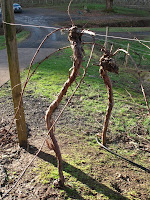Happy New year to you all!
I hope you had a great one. I went up to Seattle with my husband and drank at least 5 types of Champagne/Sparkling wine with my brother, his wife and their friends and I think Gloria Ferrer Sonoma Brut out of California is still one of my favorites. The wine is balanced, has nice fruit, good acidity, some creaminess and is inexpensive. What more could I ask for?
As for this week, it’s back to the grind stone. We are starting to look at when we might bottle the whites which means enough of these lazy days, I must get working!! Yesterday I checked the rest of the BeckenRidge Pinot for ML and the barrels are mostly done and Chardonnay is even a third finished. This is exciting, though it means even more up coming work there. When the Pinot is finished with ML I will rack every barrel to a clean barrel to get the wine off the lees. I’ll tell you more about that when it happens, pictures will help. I also spent the day topping all the barrels and except for the odd barrel everything is smelling great!
I sulfured my first barrels today which means I made up a solution of SO2 and added it to every barrel of Maréchal Foch; I then stirred the barrels, topped them and finally changed out the bungs. The first bungs I use are designed to let gas escape, both from the end of fermentation and also the slight amount produced during malo-lactic fermentation. Now that the processes are over I am trying to minimize oxygen exposure and so replaced them all with solid bungs that shouldn’t let in any air. Of course there is always some exchange of oxygen through the wood of the barrel which is part of the aging process and why the wine is in barrel for at least 9 months but it is much slower than what would come through a loose fitting bung. The micro-oxygenation that occurs softens the wine and makes it ready to drink sooner. It reduces some of the tannins by binding them up and allows other flavors to show through. If you are ever in the neighborhood during the week I would be glad to let you taste so you can see what I mean.


 Pruning has started in the vineyard and the guys are wishing for all the sunny or at least non-rainy days they can get. It will take them several weeks to go through and prune every plant and pull the old canes off the wires. Next month they will go through again and wrap this year’s canes around the wires in preparation for this year’s growth. I always find it amazing how much the plant grows every year. Below is a picture of the same Chardonnay vine that I showed a few weeks ago so you can see the before and after.
Pruning has started in the vineyard and the guys are wishing for all the sunny or at least non-rainy days they can get. It will take them several weeks to go through and prune every plant and pull the old canes off the wires. Next month they will go through again and wrap this year’s canes around the wires in preparation for this year’s growth. I always find it amazing how much the plant grows every year. Below is a picture of the same Chardonnay vine that I showed a few weeks ago so you can see the before and after.
























